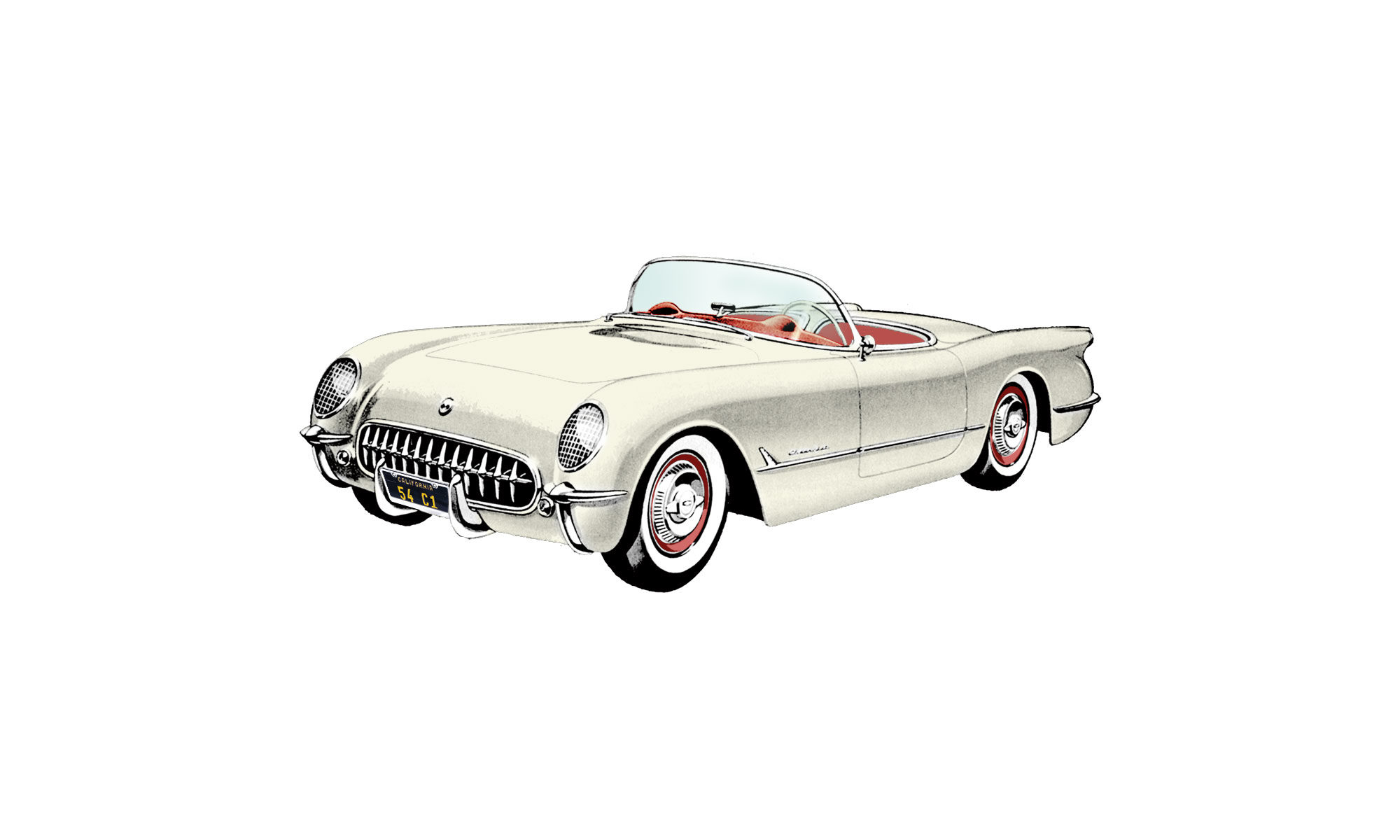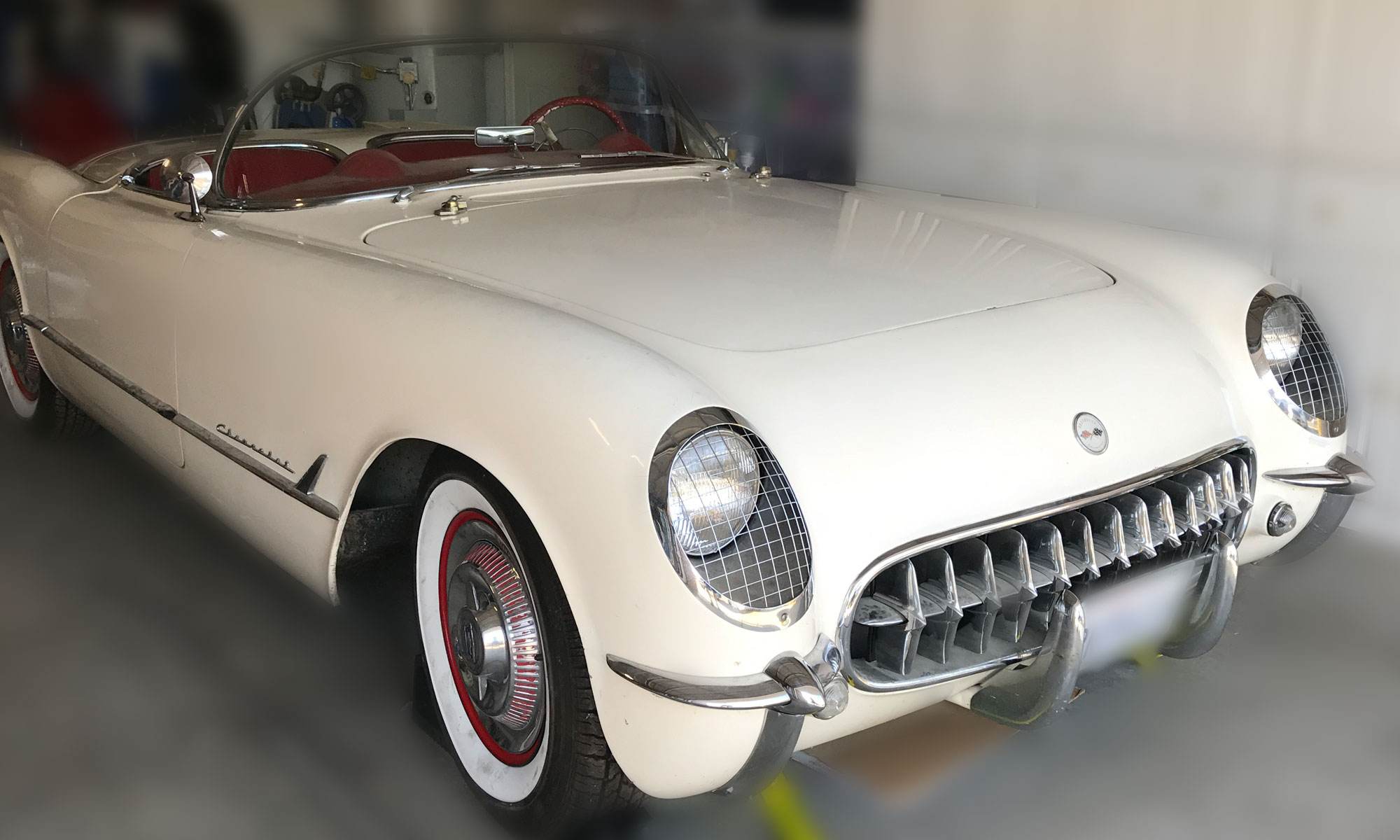The Chevrolet Corvette (C1) is the first generation of the Corvette sports car produced by Chevrolet. It was introduced late in the 1953 model year, and produced through 1962. It is commonly referred to as the “solid-axle” generation, as the independent rear suspension did not appear until the 1963 Sting Ray. The Corvette was rushed into production for its debut model year to capitalize on the enthusiastic public reaction to the concept vehicle, but expectations for the new model were largely unfulfilled. Reviews were mixed and sales fell far short of expectations through the car’s early years. The program was nearly canceled, but Chevrolet would ultimately stay the course.
Origin 1951
In 1927 General Motors hired designer Harley Earl who loved sports cars. GIs returning after serving overseas in the years following World War II were bringing home MGs, Jaguars, Alfa Romeos, and the like. In 1951, Nash Motors began selling an expensive two-seat sports car, the Nash-Healey, that was made in partnership with the Italian designer Pinin Farina and British auto engineer Donald Healey, but there were few moderate-priced models. Earl convinced GM that they needed to build a two-seat sports car, and with his Special Projects crew began working on the new car, “Project Opel” in late 1951. The result was the hand-built, EX-122 pre-production Corvette prototype, which was first shown to the public at the 1953 General Motors Motorama at the Waldorf-Astoria in New York City on January 17, 1953. Production began six months later. The car is now located at the Kerbeck Corvette museum in Atlantic City and is believed to be the oldest Corvette in existence.
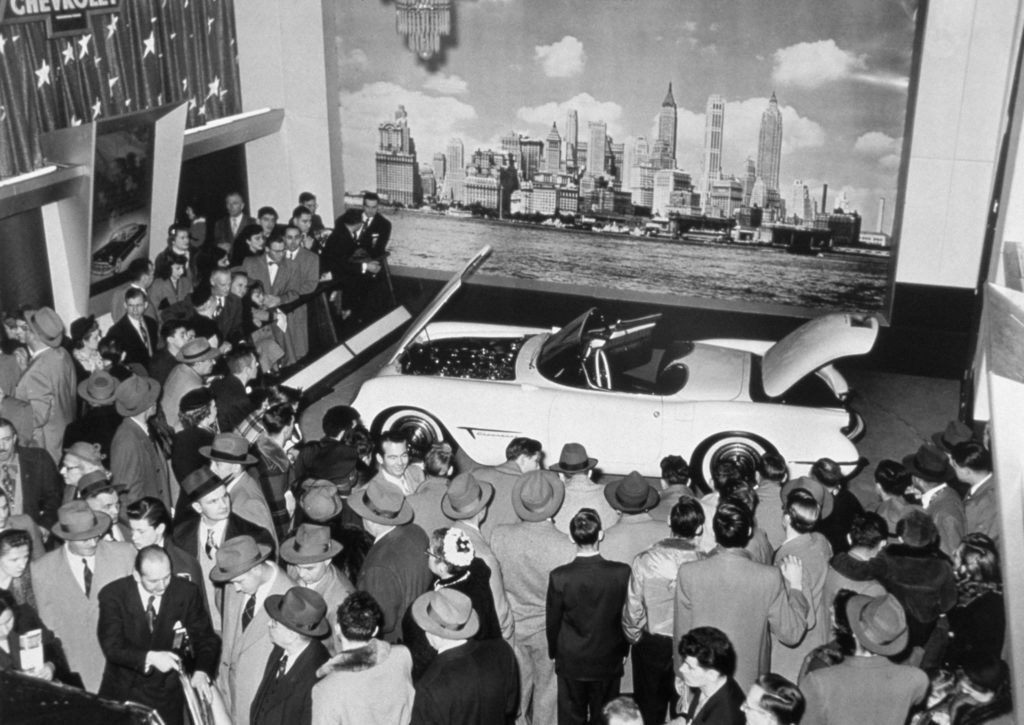
Design and engineering
To keep costs down, GM executive Robert F. McLean mandated off-the-shelf mechanical components, and used the chassis and suspension design from the 1949–1954 Chevrolet passenger vehicles. The drivetrain and passenger compartment were moved rearward to achieve a 53/47 front-to-rear weight distribution. It had a 102-inch wheelbase. The engine was a 235 cu in (3.85 L) inline six engine that was similar to the 235 engine that powered all other Chevrolet car models, but with a higher-compression ratio, three Carter side-draft carburetors, mechanical lifters, and a higher-lift camshaft. Output was 150 horsepower (110 kilowatts). Because there was currently no manual transmission available to Chevrolet rated to handle 150 HP, a two-speed Powerglide automatic was used. 0–60 mph (0–97 km/h) time was 11.5 seconds.
During the last half of 1953, 300 Corvettes were to a large degree, hand-built on a makeshift assembly line that was installed in an old truck plant in Flint, Michigan while a factory was being prepped for a full-scale 1954 production run. The outer body was made out of then-revolutionary glass fiber reinforced plastic material. Although steel shortages or quotas are sometimes mentioned as a factor in the decision to use fiberglass, no evidence exists to support this. In calendar years 1952 and 1953 Chevrolet produced nearly 2 million steel bodied full-size passenger cars and the intended production volume of 10,000 Corvette for 1954 was only a small fraction of that.
The body engineer for the Corvette was Ellis James Premo. He presented a paper to the Society of Automotive Engineers in 1954 regarding the development of the body. Several excerpts highlight some of the key points in the body material choice:
The body on the show model was made of reinforced plastic purely as an expedient to get the job done quickly.
Although we were going ahead with the building of an experimental plastic body in order to get a car rolling for chassis development work – at the time of the Waldorf Show, we were actually concentrating body-design-wise on a steel body utilizing Kirksite tooling for the projected production of 10,000 units during the 1954 model year. It was some time later that we decided to produce this quantity in reinforced plastic.
About this time, some doubt was expressed that we should build the 1954 model of steel. People seemed to be captivated by the idea of the fiberglass plastic body. Furthermore, information being given to us by the reinforced plastic industry seemed to indicate the practicality of fabricating plastic body parts for automobiles on a large scale.
The Mastermind of the Corvette’s Fiberglass Body from Molded Fiber Glass Companies on Vimeo.
A 55 degree raked windshield was made of safety glass, while the license plate holder was set back in the trunk, covered with a plastic window. Underneath the new body material were standard components from Chevrolet’s regular car line, including the “Blue Flame” inline six-cylinder engine, two-speed Powerglide automatic transmission, and drum brakes. The engine’s output, 136 hp (101 kW), was increased however from a Carter triple-carburetor system exclusive to the Corvette, but performance of the car was decidedly “lackluster”. Compared to the British and Italian sports cars of the day, the Corvette lacked a manual transmission and required more effort to bring to a stop, but like their British competition, such as Morgan, was not fitted with roll-up windows; this would have to wait until sometime in the 1956 model year. A Paxton centrifugal supercharger became available in 1954 as a dealer-installed option, greatly improving the Corvette’s straight-line performance, but sales continued to decline.
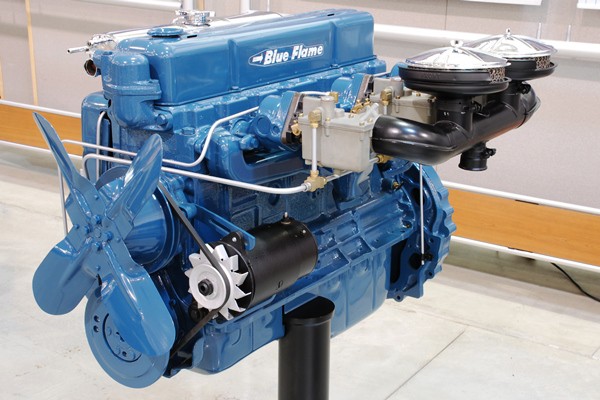
The Chevrolet division was GM’s entry-level marque. Managers at GM were seriously considering shelving the project, leaving the Corvette to be little more than a footnote in automotive history, and would have done so if not for three important events. The first was the 1955 introduction of Chevrolet’s first V8 engine since 1919. Late in the model year, the new 195 hp (145 kW) 265 small-block became available with a Powerglide automatic transmission, until the middle of the production year when a manual 3-speed became available, coupled to a 3.55:1 axle ratio, the only one offered. The engine was fitted with a single 2218S or 2351S WCFB four-barrel (four-choke) Carter carburetor. The combination turned the “rather anemic Corvette into a credible if not outstanding performer”. The second was the influence of a Russian émigré in GM’s engineering department, Zora Arkus-Duntov. The third factor in the Corvette’s survival was Ford’s introduction of the 1955 two-seat Thunderbird, which was billed as a “personal luxury car”, not a sports car. Even so, the Ford-Chevrolet rivalry in those days demanded GM not appear to back down from the challenge. The original concept for the Corvette emblem incorporated an American flag into the design, but was changed well before production since associating the flag with a product was frowned upon.
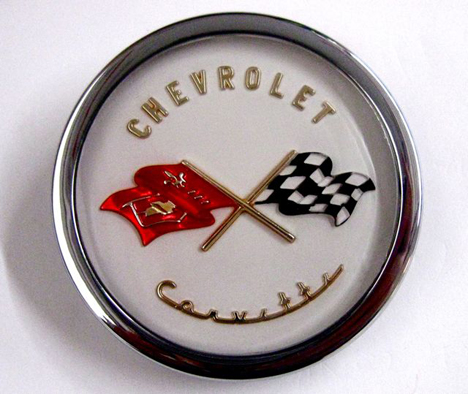
1953 Corvette
The 1953 model year was not only the Corvette’s first production year, but at 300 produced it was also the lowest-volume Corvette. The cars were essentially hand-built and techniques evolved during the production cycle, so that each 1953 Corvette is slightly different. All 1953 models had Polo White exteriors, red interiors, and black canvas soft tops. Order guides showed heaters and AM radios as optional, but all 1953 models were equipped with both. Over two hundred 1953 Corvettes are known to exist today. They had independent front suspension, but featured a rigid axle supported by longitudinal leaf springs at the rear. The cost of the first production model Corvettes in 1953 was $3490.
The quality of the fiberglass body as well as its fit and finish was lacking. Other problems, such as water leaks and doors that could open while the car was driven, were reported with the most severe errors corrected in subsequent units produced, but some shortcomings continued beyond the Corvette’s inaugural year. By December 1953, Chevrolet had a newly equipped factory in St. Louis ready to build 10,000 Corvettes annually. However, negative customer reaction in 1953 and early 1954 models caused sales to plummet.
In 1954, only 3,640 of this model were built and nearly a third were unsold at year’s end. New colors were available, but the six-cylinder engine and Powerglide automatic, the only engine and transmission available, were not what sports car enthusiasts expected. It is known that 1954 models were painted Pennant Blue, Sportsman Red, and Black, in addition to Polo White. All had red interiors, except for those finished in Pennant Blue which had a beige interior and beige canvas soft top. Order guides listed several options, but all options were “mandatory” and all 1954 Corvettes were equipped the same.
1954 Chevrolet Corvette.
In the October 1954 issue of Popular Mechanics there was an extensive survey of Corvette owners in America. The surprising finding was their opinions in comparison to foreign sports cars. It was found that 36% of those taking the survey had owned a foreign sports car, and of that, half of them rated the Corvette as better than their previous foreign sports car. Nineteen percent rated the Corvette as equal to their foreign sports car and 22% rated the Corvette as inferior. While many were well pleased with the Corvette, they did not consider it as a true sports car. The principal complaint of the surveyed owners was the tendency of the body to leak extensively during rain storms.
Chevrolet debuted its 265 cu in (4.34 L) small-block, 195 hp (145 kW) V8 in 1955 and the engine found its way into the Corvette. At first 1955 V8 Corvettes continued with the mandatory-option Powerglide automatic transmission (as did the few 6-cylinder models built), but a new three-speed manual transmission came along later in the year for V8 models only. Exterior color choices were expanded to at least five, combined with at least four interior colors. Even soft-tops came in three colors and different materials. Despite all this, only 700 1955 Corvettes were built, making it second only to 1953 in scarcity. Very few six-cylinder 1955 models were built, and all documented examples are equipped with automatic transmissions. The “V” in the Corvette emblem was enlarged and gold colored, signifying the V8 engine under the hood and 12 volt electrical systems, while 6-cylinder models retained the 6-volt systems used in 1953-54. Rare option estimate: Manual transmission (75).
Although not a part of the original Corvette project, Zora Arkus-Duntov was responsible for the addition of the V8 engine and three-speed manual transmission. Duntov improved the car’s marketing and image and helped the car compete with the new V8—engined Ford Thunderbird, and turned the Corvette from its lackluster performance into a credible performer. In 1956 he became the director of high-performance vehicle design and development for Chevrolet helping him earn the nickname “Father of the Corvette.”
Although the C1 Corvette chassis and suspension design were derived from Chevrolet’s full-size cars, the same basic design was continued through the 1962 model even after the full-size cars were completely redesigned for the 1955 model year. This was due to the combined factors of the relatively high re-engineering and re-tooling costs for this low-volume production vehicle, the continued potential for cancellation of the car, and the increased size and weight of the all-new suspension design for the full-size cars, which made it unsuitable for use in the lighter weight Corvette.
